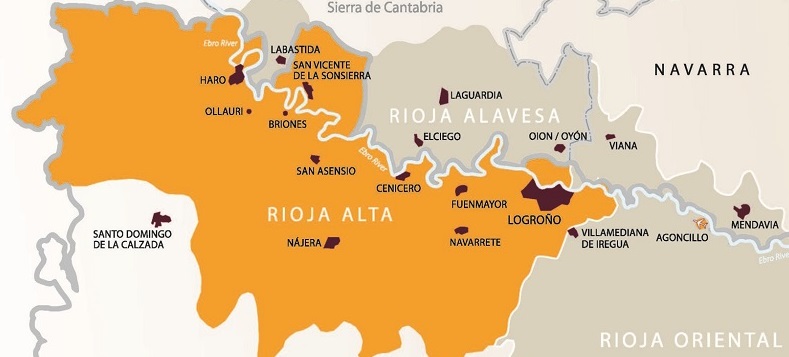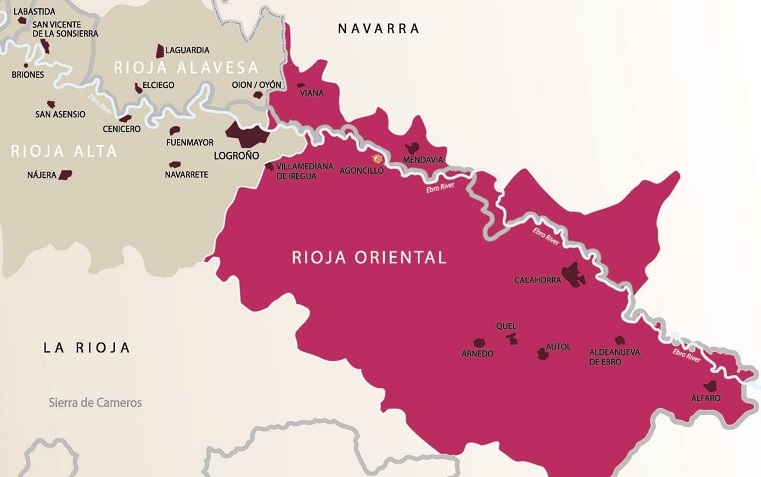Rioja Reserva (Spain)
Rioja is a DOC wine region in Northern Spain.
Rioja Reserva is from selected wines from exceptional vintages, with at least 2 years in oak and 3 years in the bottle.
A typical Rioja blend consists of approx. 60% Tempranillo and up to 20% Garnacha.
Rioja Grand Riserva Aromas
Aromas of ripe red and black fruits is Tempranillo's hallmark, with hints of herbs, licorice, anise, and minerals. Young Tempranillo offers flavours of cherry, plum, tomato and dried fig.
Red Cherry |
Black Cherry |
Tomato |
Blackberry |
Plum |
Fig |
Herbs |
Licorice |
Secondary Aromas
Vanilla |
Coconut |
Cloves |
Cinnamon |
Oak aging imparts sweet vanilla, coconut and spicy notes such as cloves and cinnamon.
Tertiary Aromas
Cedar |
Dill |
Raisins |
Licorice |
Leaves |
Leather |
Tobacco |
Cigar Box |
With age, flavours of cedar, leather, tobacco, vanilla and dill can evolve in the bottle. Aromas of dried leaves and underbrush are also common.
Rioja Grand Riserva Profile
Rioja Grand Riserva is a Full Bodied red wine:
| SUGAR: | Dry (3 g/l) | ||
| BODY: | Full | ||
| TANNINS: | High | ||
| FRUIT: | Medium | ||
| ACIDITY: | Medium | ||
| |||
Rioja Grand Riserva Food Pairing
Tapas |
Ham |
Chorizo |
Chili |
Pasta |
Pizza |
Lasagna |
Hamburger |
Chicken |
Rabbit |
Pork |
Lamb |
Rioja Grand Riserva is perfect with Lamb and Pork.
It is also perfect with Filet Mignon, but lacks the tannins for a fat Beef.
Young Rioja Grand Riserva pairs well with both Spicy and Tomato based dishes.
Excellent Pairings
Tapas. Olives. Cold Cuts. Chorizo.
Casseroles. Savory Stews. Moroccan Tagine.
Red Pepper Dishes.
Tacos. Nachos. Burritos.
Roasted Meat. Lamb. Pork. Poultry.
Mushroom Dishes.
Spanish Specialities
Chili con Carne.
Grilled Suckling Lamb (Lechazo).
Grilled Suckling Pig.
Grilled Lamb Chops.
The Ideal Glass for Rioja Grand Riserva
The Bordeaux Glass was designed for enjoying fuller-bodied, tannic red wines.

|
They are taller than other red wine glasses, and has a slimmer bowl.
The slimmer bowl directs the wine to the back of your mouth for a maximum taste. The size also allows the bouquet of the wine to develop, smooth out rough edges, play down tannins, and allow the wine to achieve balance. |
If You Like Rioja Grand Riserva
You Might Also Like:
About Tempranillo

Tempranillo is the noble grape variety of Spain, just like Cabernet Sauvignon is to France.
It is the most planted red wine grape in Spain and the third most planted in the world.
Tempranillo is high quality red wine grape that is grown all over Spain except in the hot South.
In Spain, Tempranillo thrives best in the cooler wine regions of Rioja and Ribera del Duero.
It is known as Tinto Fino in Ribera del Duero, Cencibel in La Mancha Valdepenas and Ull de Llebre (Eye of the Hare) in Catalonia, and "Aragonez" or "Tinta Roriz" in Portugal (used in Port wine). Its spiritual home is in Rioja and Navarra where it constitutes around 70% of most red blends.
The name comes from Spanish temprano which means early" and refers to early ripening.
Young Tempranillo wine has medium color, moderate acidity, and a fine berry-like character, while aged Tempranillo often develops a sweet spicy, leather and tobacco-like flavor.
Tempranillo wines are generally softer and rounder than Bordeaux wines, but drier than Burgundy wines.
Medium acidity and moderate tannins make Tempranillo wines round and soft, with a spicy aftertaste. The wines are easy to like, and easy to pair with many types of food.
Cherries and Red and Black Berries are typical Tempranillo flavors, with hints of Herbs, Licorice, Spices, and Minerals.
Terroir
Tempranillo loves calcareous clay soils but performs well also in limestone, chalck and iron rich ones. It performs best in "La Rioja" and "Ribeira del Duero" in Spain.
Spanish Tempranillo DO Regions
Rioja was the first Spanish region to be awarded DOCa status (1991).
Rioja wines are normally a blend of various grapes. A typical blend consists of 65% to 85% Tempranillo and up to 20% Garnacha.
| Rioja Joven Less than one year in Oak. |
60-80% Tempranillo 20% Garnacha |
| Rioja Crianza DOCa Min 24 months aging. One year in Oak. |
60-80% Tempranillo 20% Garnacha |
| Rioja Reserva DOCa Min 36 months aging. One year in Oak. |
60-80% Tempranillo 20% Garnacha |
| Rioja Grand Reserva DOCa Min 60 months aging. Two years in Oak. |
60-80% Tempranillo 20% Garnacha |
| Ribera del Duero DO | 90-100% Tempranillo |
| Toro DO | 90-100% Tinta de Toro |
Wine Region Rioja
Rioja is a famous wine region in the north-central part of Spain. It is Spain’s largest red wine producing region with over 600 wineries and an annual production of over 400 million bottles.
The Rioja region is a denominación de origen calificada, "Qualified Designation of Origin (D.O.Ca)", the highest category in Spanish wine regulation.
Rioja wines ares made from grapes grown in La Rioja and Navarre, and the Basque province of Álava.
The key appellations are Rioja Alta, Rioja Alavesa, and Rioja Oriental (previously Rioja Baja).
Rioja Alta (Rioja High)

Rioja Alta is Located on the western side of Rioja. It has an Atlantic climate, and its soils consist of iron-rich clay mixed with limestone. Thanks to the elevation and cooler temperatures, Rioja Alta wines have more tannin and higher acidity than Rioja Oriental, and they are often more elegant.
Rioja Alavesa

Rioja Alavesa is the smallest of the Rioja regions. It is located between the Ebro River and the rocky mass of the Sierra Cantabria. The wines bear a high resemblance to the wines of Rioja Alta with high tannins and high acidity.
The vineyards here are located at high altitudes, resulting in cooler temperatures that aid in the acquisition acid levels and good colour. The soil is rich in chalky clay, limestone and sand.
Rioja Oriental (Rioja East)

The wines from Rioja Oriental (Rioja East), formerly the Rioja Baja (Rioja Low) are fruit-forward and the wineries focus on wines designed to drink young.
Red Wines
The region is best known for high-quality Rioja Wines.
A typical Rioja blend consists of 60% Tempranillo ("the Grape of Spain") and 20% Garnacha along with other fruity additives like Mazuelo (Cariñena) and Graciano.
White Wines
Viura (Macabeo) is the dominant white grape in Rioja, accounting for 70% of white varieties.
Viura is also found in France, particularly in Roussillon and the Languedoc, where it is called Maccabeo or Maccabeu.
Nine white varieties is allowed to use in white Rioja: Viura, Malvasía Riojana, Garnacha Blanca, Chardonnay, Sauvignon Blanc, Verdejo, Maturana Blanca, Tempranillo Blanco and Torrontés.
DOCa Rioja (La Rioja)
Rioja was the first Spanish wine region to obtain DO status in 1925. In 1991, it was promoted to DOCa (Qualified Designation of Origin), a higher category reserved for wines maintaining a proven consistency and quality over a long period of time.
| Black Grapes | White Grapes |
|
88% Tempranillo |
70% Viura (Macabeo) |
| Red Wines | White Wines |
|
|
Viura (Macabeo) |
| Soil | Climate |
|
Rioja Alta: Rioja Alavesa:
Rioja Oriental (Baja): |
Hilly Riverbanks. |

Alcohol can be addictive. Always drink in moderation.
© Copyright 2015-2025 W3 Wine School. All Rights Reserved.














